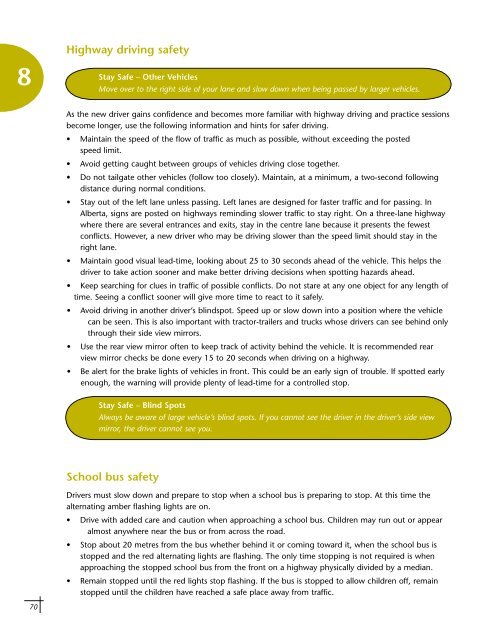Geared to Go A Workbook for Coaching New Drivers
Geared to Go A Workbook for Coaching New Drivers
Geared to Go A Workbook for Coaching New Drivers
Create successful ePaper yourself
Turn your PDF publications into a flip-book with our unique Google optimized e-Paper software.
8Highway driving safetyStay Safe – Other VehiclesMove over <strong>to</strong> the right side of your lane and slow down when being passed by larger vehicles.As the new driver gains confidence and becomes more familiar with highway driving and practice sessionsbecome longer, use the following in<strong>for</strong>mation and hints <strong>for</strong> safer driving.• Maintain the speed of the flow of traffic as much as possible, without exceeding the postedspeed limit.• Avoid getting caught between groups of vehicles driving close <strong>to</strong>gether.• Do not tailgate other vehicles (follow <strong>to</strong>o closely). Maintain, at a minimum, a two-second followingdistance during normal conditions.• Stay out of the left lane unless passing. Left lanes are designed <strong>for</strong> faster traffic and <strong>for</strong> passing. InAlberta, signs are posted on highways reminding slower traffic <strong>to</strong> stay right. On a three-lane highwaywhere there are several entrances and exits, stay in the centre lane because it presents the fewestconflicts. However, a new driver who may be driving slower than the speed limit should stay in theright lane.• Maintain good visual lead-time, looking about 25 <strong>to</strong> 30 seconds ahead of the vehicle. This helps thedriver <strong>to</strong> take action sooner and make better driving decisions when spotting hazards ahead.• Keep searching <strong>for</strong> clues in traffic of possible conflicts. Do not stare at any one object <strong>for</strong> any length oftime. Seeing a conflict sooner will give more time <strong>to</strong> react <strong>to</strong> it safely.• Avoid driving in another driver’s blindspot. Speed up or slow down in<strong>to</strong> a position where the vehiclecan be seen. This is also important with trac<strong>to</strong>r-trailers and trucks whose drivers can see behind onlythrough their side view mirrors.• Use the rear view mirror often <strong>to</strong> keep track of activity behind the vehicle. It is recommended rearview mirror checks be done every 15 <strong>to</strong> 20 seconds when driving on a highway.• Be alert <strong>for</strong> the brake lights of vehicles in front. This could be an early sign of trouble. If spotted earlyenough, the warning will provide plenty of lead-time <strong>for</strong> a controlled s<strong>to</strong>p.Stay Safe – Blind SpotsAlways be aware of large vehicle’s blind spots. If you cannot see the driver in the driver’s side viewmirror, the driver cannot see you.School bus safety<strong>Drivers</strong> must slow down and prepare <strong>to</strong> s<strong>to</strong>p when a school bus is preparing <strong>to</strong> s<strong>to</strong>p. At this time thealternating amber flashing lights are on.• Drive with added care and caution when approaching a school bus. Children may run out or appearalmost anywhere near the bus or from across the road.• S<strong>to</strong>p about 20 metres from the bus whether behind it or coming <strong>to</strong>ward it, when the school bus iss<strong>to</strong>pped and the red alternating lights are flashing. The only time s<strong>to</strong>pping is not required is whenapproaching the s<strong>to</strong>pped school bus from the front on a highway physically divided by a median.• Remain s<strong>to</strong>pped until the red lights s<strong>to</strong>p flashing. If the bus is s<strong>to</strong>pped <strong>to</strong> allow children off, remains<strong>to</strong>pped until the children have reached a safe place away from traffic.70




